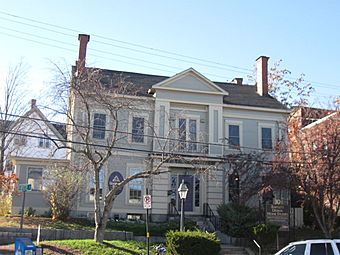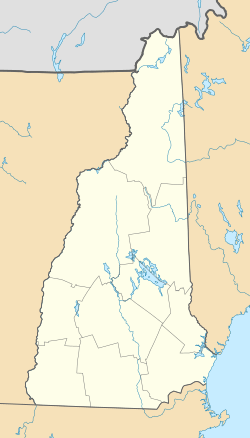Farrington House facts for kids
Quick facts for kids |
|
|
Farrington House
|
|
 |
|
| Location | 30 S. Main St., Concord, New Hampshire |
|---|---|
| Area | less than one acre |
| Built | 1844 |
| Built by | John Leach |
| Architectural style | Greek Revival |
| NRHP reference No. | 82001858 |
| Added to NRHP | March 9, 1982 |
The Farrington House is a special old building located at 30 South Main Street in Concord, New Hampshire. It was built a long time ago, in 1844, and was actually designed to be two homes in one! This house is a great example of a building style called Greek Revival. Because it's so important, it was added to the National Register of Historic Places in 1982.
Contents
What is the Farrington House?
The Farrington House stands on the edge of downtown Concord. It's a two-and-a-half story house made of wood. It has a pointed roof and brick chimneys on the sides. Most of the outside is covered with wooden boards called clapboards.
Greek Revival Style
The house shows off a classic Greek Revival design. This style was popular in the 1800s and often looks like ancient Greek temples. The Farrington House has a special front section that goes up two stories. This part covers the main entrance, which has tall windows on the sides. The bottom part of this section looks like it's made of big stone blocks, even though it's wood. The top part has flat, decorative columns supporting a triangular roof section.
A House for Two Families
Even though it looks like one big house, the Farrington House was built in 1844 for two brothers, Samuel and Philip Farrington. It was designed as a "duplex," meaning two separate living spaces under one roof. The single front door leads into a central hallway. From this hall, there are two curving staircases and separate entrances to each brother's living room. This two-family design continues into the back part of the house.
Who Built This House?
The Farrington brothers hired John Leach to build their unique home. John Leach was a well-known architect and builder in central New Hampshire during that time. The property also has a separate brick building called a carriage house. This was built later, when a man named Joseph Lund, who built boats, owned the house.



